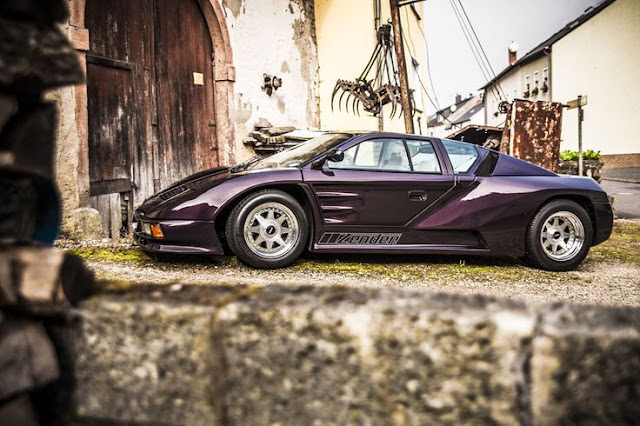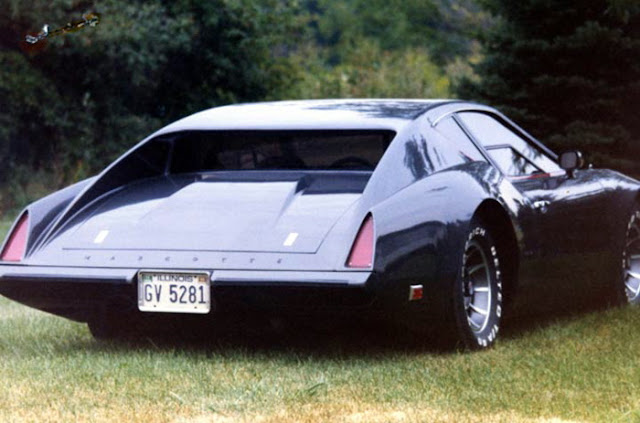The USA, it turns out, isn't the only place where many of the most successful companies got their start in a garage. One such company, was founded as a sole proprietorship in 1969 by Hans-Albert Zender under the name "HAZ". At the age of only 23, he produced individual fiberglass shelled car seats on special request. It all started in a garage in Bassenheim near Koblenz, Germany.
As a passionate motorsports enthusiast, with a particularly strong sense of aesthetics, Hans-Albert Zender quickly made a name for himself in the car scene. Soon he could no longer meet the rising demand alone and gradually expanded his company and also the range of products on offer. Car body parts such as front and rear spoilers, fenders and other embellishments made ZENDER known worldwide. His design studies, such as the VISION series, are still associated with the highest finish and quality of design.
 |
| The Zender Vision 3C |
The most well known concepts in Zender's Vision series were the cabrio and coupe versions of the Vision 3. The cabriolet version, the VISION 3c, was first shown at the Geneva Automotive Salon in 1986. Initially it was a rolling display model, however a running version was later produced using Mercedes Benz running gear. The concept made quite a splash in Geneva and was featured on the covers of most major car magazines of the day. The design was a tasteful blend of styling cues from several contemporary supercars. Proportions were typical of mid-engine designs of the era with an extreme cab-forward layout and flared bodywork housing wide, low profile tires and deep dish wheels.
Zender presented the Vision 3 coupe in 1987 as a fully functioning supercar. The engine from a Mercedes 560 SEL powered the Vision 3, producing 300 hp and helped deliver a top speed of nearly 200mph. Thanks to the skills of designer Günther Zillner, the aerodynamics were wind tunnel optimized to such an extent that the body generated significant downforce without a rear wing. The fiberglass and ABS plastic bodywork was mounted to a tubular spaceframe chassis and tub in steel and aluminum with the motor mounted longitudinally. Like its predecessor, the Vision 3 coupe found its way to the covers of top car magazines of the day and received high praise.
 |
| The Zender Vision series, at left the Vision 1, center the Vision 3, and the Vision 2 in red |
Exact numbers are hard to come by but at least 2 cabriolets and 3 coupe examples of the Vision 3C and Vision 3 were made. At least one was rumored to be in the hands of the Sultan of Brunei and others were said to have been commissioned by "wealthy Middle-Eastern clientele". Zender followed up with two more mid-engine prototypes in the same vein, called the Vision Fact4 and Fact4 Roadster respectively.
Zender established itself as one of the premier German tuning houses and makers of aftermarket auto accessories in the 1980's, alongside Koenig, B&b, and Strosek. Their success in that line of business continued well into the 2000's. However, the company elected to focus exclusively on their "personalization" services in 2008, discontinuing their line of aftermarket parts. Zender currently operates a chain of custom shops and dealer outlets throughout the EU.
 |
| The Zender Vision 3, at rear |
The Vision 3 remains an iconic 80's dream car, a perfectly distilled product of its time.
Sources:
 |
| The Zender Vision Fact4 and Fact4 Roadster |
 |
| The Zender Vision 3C |
 |
| The Zender Vision 3, original prototype |
 |
| The Zender Vision 3, from above |
 |
| The Zender Vision 3 in profile |
 |
| The Zender Vision 3, front quarter |
 |
| The Zender Vision 3, rear quarter view |
 |
| The Zender Vision 3, open from above |
 |
| The Zender Vision 3, in the wild |
 |
| The Zender Vision 3, open from above, rear |
 |
| The Zender Vision 3 in profile |
 |
| The Zender Vision 3C |
 |
| The Zender Vision 3, as shown in 1987 |
 |
| The Zender Vision 3, lights up and doors open |
 |
| The Zender Vision 3 interior. |























Zender não era tão famosa assim, alem de que o fact 4 tinha um 3.6 V8 TT de 448HP e era mais icônico que o vision 3, o vision 3 chegava a 293KM/H, ja o fact 4 eram 312KM/H, e o 0-100 do fact era 1,2s mais rápido
ReplyDelete